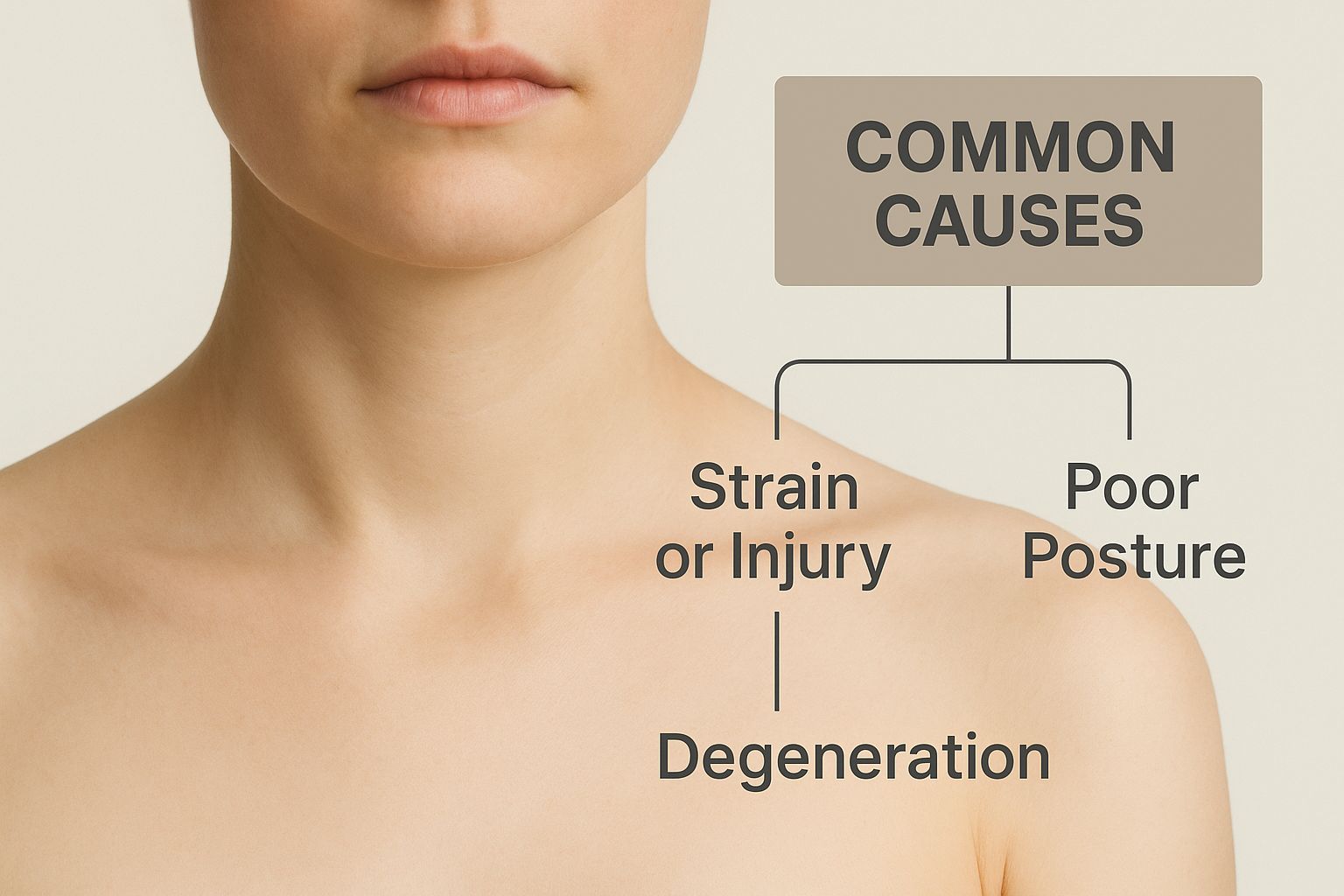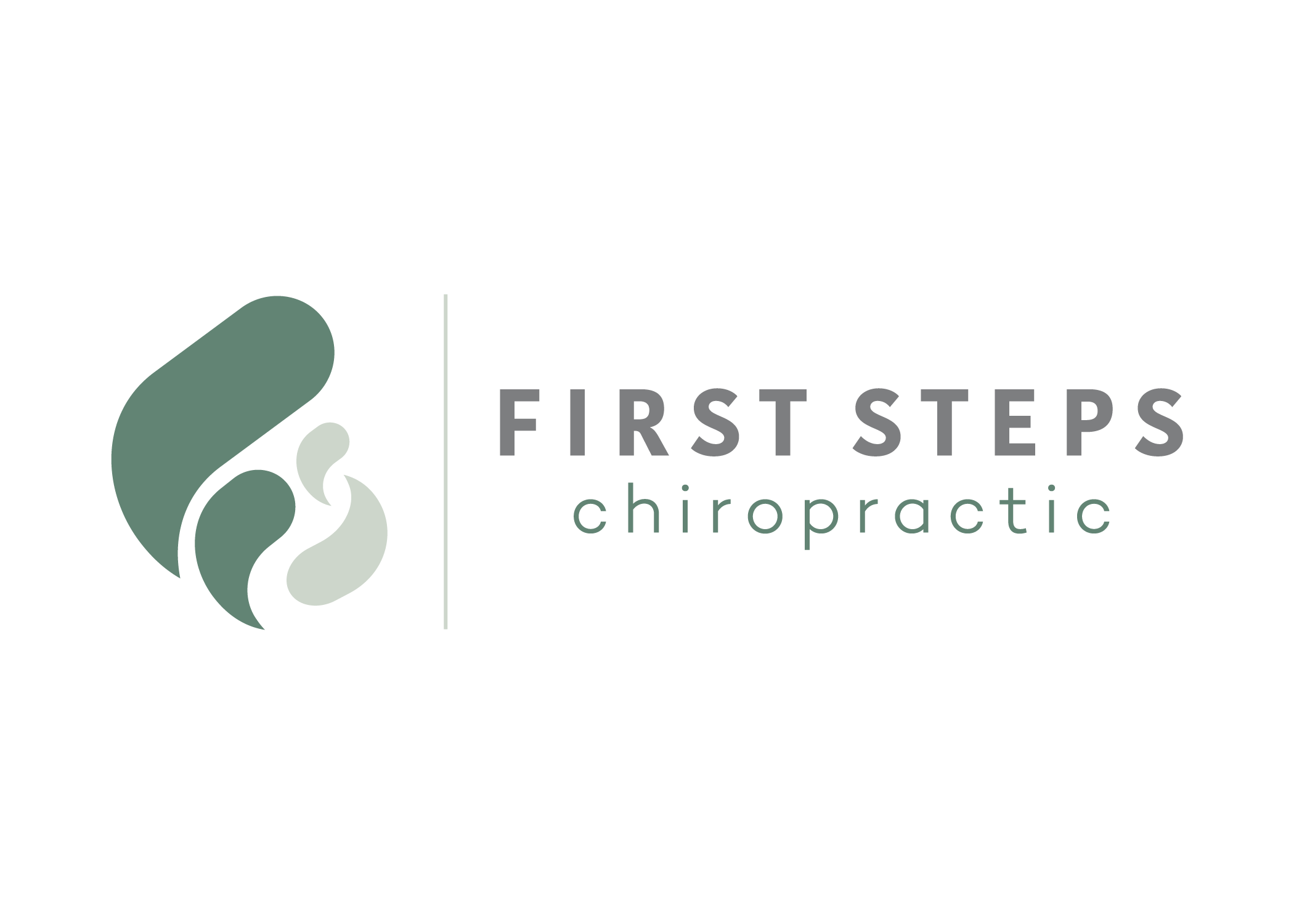When neck pain goes from a temporary nuisance to a constant companion, it's more than just frustrating—it's a sign that something deeper is going on. This is what we call chronic neck pain, a persistent ache that sticks around for three months or longer. It's not the same as the crick in your neck you get from sleeping funny; this kind of pain signals an underlying issue that your body is struggling to resolve on its own.
The causes can be anything from long-term wear and tear and poor posture to old injuries that never quite healed right, throwing your body's natural alignment out of whack.
Why Your Neck Pain Never Seems to Go Away
It’s easy to feel unheard when you're dealing with pain that just won't quit. Think of that persistent ache as your body’s alarm system, but the switch is stuck in the "on" position. It's telling you that the root problem—whether a minor injury or repetitive strain—has kicked off a cycle of inflammation, muscle tension, and nerve irritation that your body can't shut down.
And you're definitely not alone in this. Chronic neck pain is a major health issue affecting millions of people across the globe. A 2019 analysis found that at any given moment, roughly 2.7% of the global population was dealing with neck pain. The condition was responsible for a staggering 22.1 million years lived with disability worldwide. You can find more details on these global neck pain statistics on the National Center for Biotechnology Information's website.
Think of it like this: an acute injury is like a fire alarm that goes off once and is quickly silenced. Chronic pain is like a faulty alarm that keeps blaring, day after day, because no one has addressed the source of the smoke.
This constant state of high alert can create a snowball effect, leading to other problems:
- Muscular Imbalances: To protect the injured area, some muscles become perpetually tight and overworked, while others grow weak from disuse.
- Nerve Sensitization: The nerves in your neck can become hypersensitive, almost like they've developed a "short fuse." They start firing off pain signals with even the slightest provocation.
- Reduced Mobility: You naturally start to avoid movements that hurt. Over time, this leads to even more stiffness and weakness in your neck.
The first step toward relief is understanding that your pain is a real, complex physiological response. It’s not just “in your head,” and it’s not simply a normal part of getting older. By digging into the specific causes of chronic neck pain, you can start to understand what your body has been trying to tell you and find a solution that offers lasting relief, not just a temporary patch.
Decoding Your Neck's Internal Architecture
To really get to the bottom of chronic neck pain, we have to look at the a a an atomy itself. Think of your spinal discs—the little cushions between your vertebrae—as tiny, sophisticated jelly donuts. They have a tough, fibrous outer layer (the donut) and a soft, gel-like center (the jelly). This design is brilliant; it absorbs shock and allows your neck to move freely. But when this architecture starts to break down, it can become a major source of relentless pain.
This visual gives a great overview of the most common culprits behind neck pain, showing how different factors all play a role.

As you can see, the problem often starts with the gradual breakdown of these critical parts, which then triggers a cascade of painful symptoms.
When Discs and Joints Break Down
One of the most frequent structural issues we see is degenerative disc disease. Don't let the name scare you—it isn't really a "disease" but a natural process of wear and tear. Over time, your cervical discs can lose moisture, becoming thinner and less spongy. This shrinks the space between vertebrae, leading to stiffness and that all-too-familiar ache.
This degeneration often creates a domino effect. For example, once the outer wall of a disc weakens, the soft inner "jelly" can push its way out. This is what we call a bulging or herniated disc.
A herniated disc is exactly like that jelly donut getting squeezed too hard, causing the filling to ooze out. This escaped material can press directly on the sensitive nerve roots exiting your spine, causing sharp pain, numbness, or weakness that can shoot all the way down your arm.
This kind of internal pressure is a huge reason why some types of chronic neck pain are so persistent and hard to ignore.
Neck Arthritis and Bone Spurs
Another significant structural problem is cervical spondylosis, which is basically just arthritis of the neck. As your discs thin and the protective cartilage in your joints wears away, the bones in your neck start to experience more friction. The body's natural response is to try and stabilize the area by growing extra bone.
These bony growths are called bone spurs (or osteophytes). While the body’s intention is good—it's trying to add support—these spurs can end up narrowing the small openings in your vertebrae (called the foramina) where nerves pass through. This narrowing, known as foraminal stenosis, leads to nerve compression and a painful condition called cervical radiculopathy.
To help you connect these conditions to what you might be feeling, here's a quick summary of how these structural problems often manifest and can overlap.
Common Structural Causes and Their Effects
| Condition | What Happens to the Spine | Common Symptoms |
|---|---|---|
| Degenerative Disc Disease | Discs lose height and hydration, reducing the cushioning between vertebrae. | A dull, chronic ache in the neck; stiffness that worsens with movement. |
| Herniated Disc | The soft, gel-like center of a disc pushes through its tough outer layer, pressing on nearby nerves. | Sharp, shooting pain that radiates into the shoulder, arm, or hand; tingling, numbness, or muscle weakness. |
| Cervical Spondylosis | Wear and tear on the facet joints, often leading to the growth of bone spurs to stabilize the area. | General neck stiffness (especially in the morning); grinding sounds with movement; headaches at the base of the skull. |
These issues rarely happen in isolation. More often than not, they occur together, creating a complex web that is the source of many chronic neck pain cases. Understanding this internal architecture is the first step toward finding the real root of your discomfort and getting a treatment plan that fixes the underlying problem, not just masking the symptoms.
How Your Daily Habits Shape Your Neck Health

While a sudden injury or a degenerative disease can certainly cause neck pain, it’s often the small, repetitive strains from our daily lives that do the most consistent damage. These habits might seem harmless on their own, but over time, they create muscular imbalances and place a ton of stress on your cervical spine, turning little issues into major sources of discomfort.
Think of your neck like a finely tuned machine. If you drive a car with misaligned tires, the treads will wear down unevenly. The same thing happens when you force your neck into awkward positions day after day; you're slowly straining its delicate structures. The human head weighs about 10-12 pounds, and for every inch you tilt it forward, you essentially double the weight your neck has to support.
This effect is everywhere in our modern, digital lives, and it has created one of the most common causes of chronic neck pain we see today.
The Rise of Tech Neck
The term "tech neck" is the perfect way to describe that forward-head posture so many of us fall into while looking down at our phones, tablets, and laptops.
Imagine you’re trying to balance a bowling ball on a stick. As long as the ball is centered, it’s relatively stable. The moment it tilts forward, however, the muscles holding it up have to work exponentially harder to keep it from falling. This is exactly what’s happening with your neck.
That constant downward gaze forces the muscles in the back of your neck (the posterior cervical muscles) to overwork, leading to fatigue, tightness, and that nagging, persistent pain. At the same time, the muscles in the front of your neck grow weak from underuse, creating a significant imbalance that just makes the problem worse.
When your head is tilted forward at a 45-degree angle to look at your phone, the force on your neck is equivalent to lifting nearly 50 pounds. Holding that kind of tension for hours is a direct pathway to chronic inflammation and strain.
Poor Workplace and Home Ergonomics
The environment where you spend most of your day plays a huge part in your neck health. Many of us spend eight or more hours at a desk, often in a setup that practically encourages poor posture and becomes another leading cause of chronic neck pain.
Some of the most common ergonomic mistakes we see include:
- Monitor position: If your screen is too low, you'll crane your neck down. If it's too high, you'll tilt your chin up. Both positions put a serious strain on your cervical spine.
- Unsupported arms: When your arms just hang without support from armrests, their weight is constantly pulling down on your shoulder and neck muscles all day long.
- Improper chair height: Sitting too low or too high can throw your entire spinal alignment out of whack, starting from your hips and traveling right up to your neck.
It’s not just at the office, either. Simple things at home, like reading in bed with your head propped up on a mountain of pillows or slouching on the couch to watch TV, add to this cumulative strain.
The Problem with Your Sleep and Bag
Even the way you sleep and what you carry can be sneaky culprits. Sleeping on your stomach is a big one, as it forces you to twist your head to one side for hours, locking your cervical spine in an unnatural position. Using a pillow that's too thick or too flat can also push your neck out of alignment with the rest of your spine.
Then there’s the heavy bag, purse, or backpack you sling over one shoulder every day. This creates an uneven load, forcing the muscles on that side to stay contracted just to hold the weight up. It leads to a lopsided posture, muscle knots, and, eventually, chronic pain. These habits, though they seem small, compound daily and become significant triggers for neck pain.
The Lingering Effects of Past Injuries
Sometimes, the real reason for your chronic neck pain isn’t something that happened last week. It’s the ghost of an old injury. That fall you took playing sports years ago or the whiplash from a fender bender that felt minor at the time—these things might seem like ancient history, but your body has a long memory. These past traumas can quietly set the stage for problems that don’t fully surface for months or even years down the road.
When your neck gets a sudden, forceful jolt like whiplash, it can create tiny micro-tears in the ligaments and muscles holding your cervical spine together. The sharp, initial pain might fade, but the damage can leave behind a lasting instability. It's a bigger issue than you might think; up to 30% of people who get a concussion, which often happens with whiplash, end up with persistent symptoms like chronic neck pain and stiffness.
The Body's Compensatory Cascade
After an injury, your body’s number one priority is to protect itself. It cleverly creates new movement patterns to guard the vulnerable area. Think about how you’d limp to take the pressure off a sprained ankle. Your neck does the exact same thing, just on a much smaller scale.
To shield the injured spot, some muscles will tighten up and become chronically overworked. At the same time, other muscles that aren't being used for their main job start to weaken. This imbalance completely disrupts your neck’s natural support system and is a huge reason why pain sticks around long after the original injury seems to have healed.
This protective mechanism is a great short-term fix, but it eventually creates a vicious cycle. The overworked muscles get tight and sore, while the weakened muscles can't provide proper support, putting even more stress on your joints and ligaments.
From Old Injury to Chronic Inflammation
This cycle of muscle imbalance and joint instability often spirals into a state of chronic, low-grade inflammation. The constant strain keeps the soft tissues irritated, preventing them from ever truly healing. This is how a forgotten injury becomes a constant, nagging source of pain.
This lingering inflammation can be stubborn, but targeted therapies can make a world of difference. You can learn more about how to find relief from chronic inflammation in our detailed guide. Over time, this inflammatory state can also speed up degenerative changes in the cervical spine, like arthritis, making the problem even more complex.
Breaking this cycle means doing more than just chasing the current pain. It’s about digging deep to identify and correct the compensatory patterns your body adopted years ago. By restoring proper balance and function to the muscles and joints, you can finally get to the true source of your discomfort and find lasting relief from the lingering effects of old injuries.
Why Your Location and Lifestyle Matter

It’s easy to think of chronic neck pain as just a personal problem, but it’s often a direct reflection of our environment and work habits. Where you live and what you do every day can have a massive impact on your risk. In a way, you can think of it as a public health issue, where certain societal trends create hotspots for neck pain.
For instance, take a look at areas with a high number of office-based, sedentary jobs. It's no surprise that these places often report higher rates of neck discomfort. All those hours spent slumped over a computer, plus the modern phenomenon of "tech neck" from looking down at our phones, create a perfect storm for muscle strain and spinal misalignments.
The Global Divide in Neck Pain Risks
The data really brings this connection to life. High-income regions like North America, where economies are built on desk work, actually have some of the highest neck pain rates in the world. Research from 2019 revealed an age-standardized incidence rate of 676.79 new cases per 100,000 people in these areas. This also means they carry the heaviest burden of disability from neck pain, highlighting how our modern lifestyle is a primary driver. You can learn more about the global burden of neck pain and its connection to regional factors in this detailed study.
On the flip side, other parts of the world face different, but just as serious, risks. In places where manual labor is more common, the physical strain of jobs in construction, farming, or factory work often leads to repetitive strain injuries. Over time, what starts as an acute injury can easily settle in and become a chronic condition.
Your job acts like a magnifying glass, zeroing in on certain stresses in your body. An office job intensifies postural strain, while a physically demanding one amplifies mechanical wear and tear. Both paths can unfortunately lead to the same destination: chronic neck pain.
How Societal Factors Play a Role
It's not just about your specific job, either. Broader societal norms and systems also shape your risk. For example, the presence and enforcement of workplace safety rules can make a world of difference in preventing on-the-job injuries that lead to long-term pain.
Other key societal influences include:
- Access to Healthcare: Getting in early for preventative care, like chiropractic adjustments, can stop a minor ache from turning into a major chronic problem.
- Cultural Norms: The way a society views work-life balance and physical activity can either encourage healthy habits or pave the way for pain.
- Built Environment: The very design of our cities—from walkable neighborhoods to good public transit—influences how much we move our bodies each day.
Understanding these bigger forces helps put your own experience into perspective. It shows that your neck pain might not just be about your personal habits, but is also shaped by the world you live in. This global view is essential for pinpointing all the contributing factors and creating a recovery plan that actually works.
Of course. Here is the rewritten section, crafted to sound like an experienced human expert while following all the specified requirements.
When to Get Professional Help for Your Neck Pain
While it’s always a good idea to try some self-care for minor aches and pains, there’s a point where you have to call in a professional. If your neck pain just won't quit after a few weeks, isn’t getting better with home remedies, or is actually getting worse, that’s your body sending a clear signal. Something deeper is going on.
Ignoring those signals is a bit like putting a piece of tape over your car's flashing "check engine" light. You might get a little further down the road, but eventually, that small issue could turn into a major breakdown. It’s not just about how much it hurts; it's about the type of pain and any other symptoms that are tagging along.
Red Flags That Demand Attention
Some symptoms are more than just a nuisance—they’re red flags that point to more serious underlying causes of chronic neck pain. If you experience any of the following, it's time to get an expert diagnosis, and quickly.
- Pain that radiates: Does the pain shoot from your neck down into your shoulder, arm, or hand? That often points directly to a compressed nerve, possibly from a herniated disc or a bone spur.
- Numbness or tingling: That "pins and needles" feeling or a sudden weakness in your arms or hands is a classic sign of nerve irritation or damage.
- Pain after an accident: Any significant neck pain after a car crash, a bad fall, or a sports injury needs immediate evaluation to rule out whiplash or more serious structural damage.
- Headaches and dizziness: When neck pain comes with frequent headaches (especially at the base of the skull) or a sense of dizziness, it’s a strong clue that the issue is affecting your nervous system.
The global impact of neck pain is staggering and expected to grow. Projections estimate that by 2050, the number of cases will rise by 32.5% to 269 million globally, driven by population growth and aging. You can discover more insights about these global neck pain projections on PMC.
A chiropractor will run a full exam, which might include Insight Scans, to get to the bottom of what’s causing your pain structurally. From there, we build a personalized care plan to correct the root problem, not just cover up the symptoms.
Our entire focus is on restoring proper alignment and function to your body, which is the only way to get sustainable, long-term relief. Finding the right strategies is everything, and you can learn more about how to manage chronic pain in our detailed guide.
Common Questions About Chronic Neck Pain Causes
Even after digging into the big picture of structural and lifestyle factors, you probably still have some specific questions about what's behind your chronic neck pain. It's completely normal. Let’s tackle some of the most common ones we hear from patients to give you a bit more clarity.
Can Stress Alone Cause Chronic Neck Pain?
Yes, absolutely. While stress isn't something we can see on an X-ray, it's a powerful and often underestimated contributor to chronic pain. When you're stressed out, your body's natural "fight or flight" response kicks in, causing you to unconsciously clench your jaw and tighten the muscles in your neck and shoulders.
Hold that tension for days, weeks, or months, and you've got a recipe for muscle fatigue, inflammation, and persistent pain. Stress can also pour gasoline on the fire of underlying issues like arthritis, creating a nasty feedback loop where pain fuels stress, and stress amplifies pain.
Conditions like fibromyalgia often present with symptoms that look a lot like stress-induced pain. It can be incredibly helpful to understand how to manage fibromyalgia and its complex effects on the body.
Is My Pillow a Likely Cause of My Chronic Neck Pain?
It's more than likely—it's a major suspect. Think about it: you spend hours every single night with your head on that pillow. If it’s forcing your neck into an awkward angle, whether it's too high or too flat, you're straining delicate muscles and ligaments for a third of your day.
The goal is simple: your pillow should keep your neck in a neutral line with the rest of your spine. For back sleepers, this usually means a thinner pillow. Side sleepers, on the other hand, typically need a firmer, thicker one to fill that gap between the ear and the outside of the shoulder.
Are There Any Red Flag Symptoms?
Yes, and it's critical to know them. While most chronic neck pain stems from musculoskeletal issues, certain symptoms are your body's way of screaming for immediate medical attention.
Don't ignore these "red flags":
- Neck pain that comes with a high fever and a stiff neck (this could signal meningitis).
- Severe, intense pain that starts after a major trauma like a car accident or a bad fall.
- Any neck pain accompanied by loss of bladder or bowel control, a sudden loss of coordination, or severe weakness in your arms or legs.
At First Steps Chiropractic, we don't just look at the symptoms; we dig deep to find the true source of your discomfort. If you're tired of temporary fixes and ready for a lasting solution, book a complimentary consultation today. Visit us at https://firststepschiropractic.com to get started.

